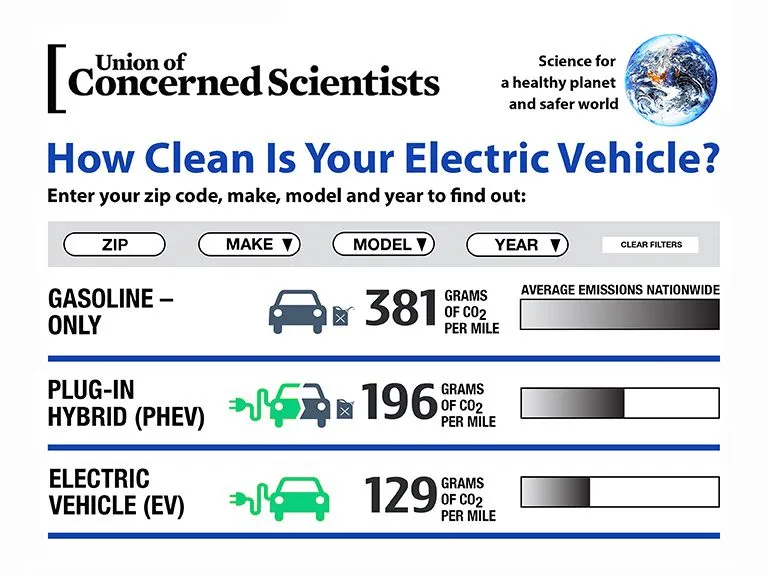
How Clean is Your EV? This Union of Concerned Scientists tool shows you!
Two-thirds of all Americans now live in areas where driving an EV produces fewer climate emissions than almost all comparable gasoline and gasoline hybrid cars—a fact attributable to more efficient EVs and an increasingly clean electricity grid.
A new tool from the UNION OF CONCERNED SCIENTISTS shows you how different types of vehicles stack up in your area:
https://www.ucsusa.org/clean-vehicles/electric-vehicles/ev-emissions-tool
Electric vehicles (EVs) are a critical part of the American transportation future given their potential to dramatically cut global warming emissions—especially when charged by a clean electricity grid.
EVs are now driving cleaner than ever before. Driving an average EV results in lower global warming emissions than driving a gasoline car that gets 50 miles per gallon (MPG) in regions covering two-thirds of the U.S. population, up from 45 percent in our 2012 report. Based on where EVs are being sold in the United States today, the average EV produces global warming emissions equal to a gasoline vehicle with a 68 MPG fuel economy rating.
But what are the global warming emissions of electric cars on a life cycle basis—from the manufacturing of the vehicle’s body and battery to its ultimate disposal and reuse? To answer this, the Union of Concerned Scientists undertook a comprehensive, two-year review of the climate emissions from vehicle production, operation, and disposal. We found that battery electric cars generate half the emissions of the average comparable gasoline car, even when pollution from battery manufacturing is accounted for.
A life cycle analysis of EVs
All vehicles experience three distinct life stages: manufacturing, operation, and end-of-life. Each stage is linked with carbon dioxide and other greenhouse gas emissions—but those emissions differ between gas-powered cars and electric cars.
Both types of vehicle begin in much the same way. Raw materials are extracted, refined, transported, and manufactured into various components that are assembled into the car itself. Because electric cars store power in large lithium-ion batteries, which are particularly material- and energy-intensive to produce, their global warming emissions at this early stage usually exceed those of conventional vehicles. Manufacturing a mid-sized EV with an 84-mile range results in about 15 percent more emissions than manufacturing an equivalent gasoline vehicle. For larger, longer-range EVs that travel more than 250 miles per charge, the manufacturing emissions can be as much as 68 percent higher.
These differences change as soon as the cars are driven. EVs are powered by electricity, which is generally a cleaner energy source than gasoline. Battery electric cars make up for their higher manufacturing emissions within eighteen months of driving—shorter range models can offset the extra emissions within 6 months—and continue to outperform gasoline cars until the end of their lives.
The specific emissions of any given EV model will depend on the vehicle’s efficiency and the electricity that powers it (check out our interactive tool to explore EV emissions in your area). For all Americans, charging the average new EV produces far fewer global warming pollutants than driving the average new gasoline car. In some of the country’s cleanest regions (including parts of California, New York, and the Pacific Northwest), driving an electric car is equivalent to getting 85 miles per gallon.
By the end of their lives, gas-powered cars spew out almost twice as much global warming pollution than the equivalent electric car. Disposing of both types of vehicles (excluding reusing or recycling their batteries) produces less than a ton each.
What’s next? Electric vehicles already result in far less climate pollution than their gas-powered counterparts, and they’re getting cleaner. Optimizing EV production and the disposal or reuse of batteries could further increase their environmental benefits. And as electricity becomes cleaner (which it is), the difference between electric cars and gasoline cars will only grow—cementing the role of electric vehicles in halving U.S. oil use and cutting global warming emissions.
https://www.ucsusa.org/clean-vehicles/electric-vehicles/ev-emissions-tool
https://www.ucsusa.org/clean-vehicles/electric-vehicles/life-cycle-ev-emissions?_ga=2.234575259.409381438.1565843132-1320321085.1565843132&_gac=1.45795344.1565843512.EAIaIQobChMInOGVzoWE5AIVhBx9Ch359wUWEAAYASAAEgIXnvD_BwE
Recent Posts
- The 2022 Audi Q4 e-Tron SUV combines performance, practicality and luxury
- Ford's 2022 F150 Lightning All-Electric Truck is in high demand
- Legendary Audi performance is at the heart of the 2022 Audi e-tron GT and its RS sibling.
- Meet the Lexus RZ 450e – the luxury brand’s 1st EV
- The 2022 GV60 is Genesis’ first all-electric vehicle

